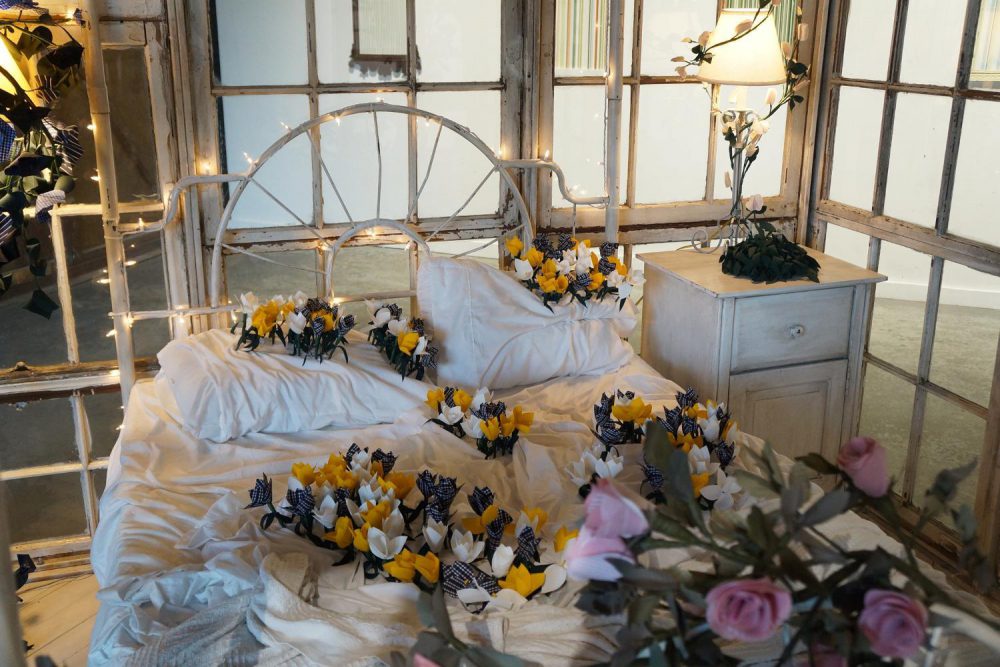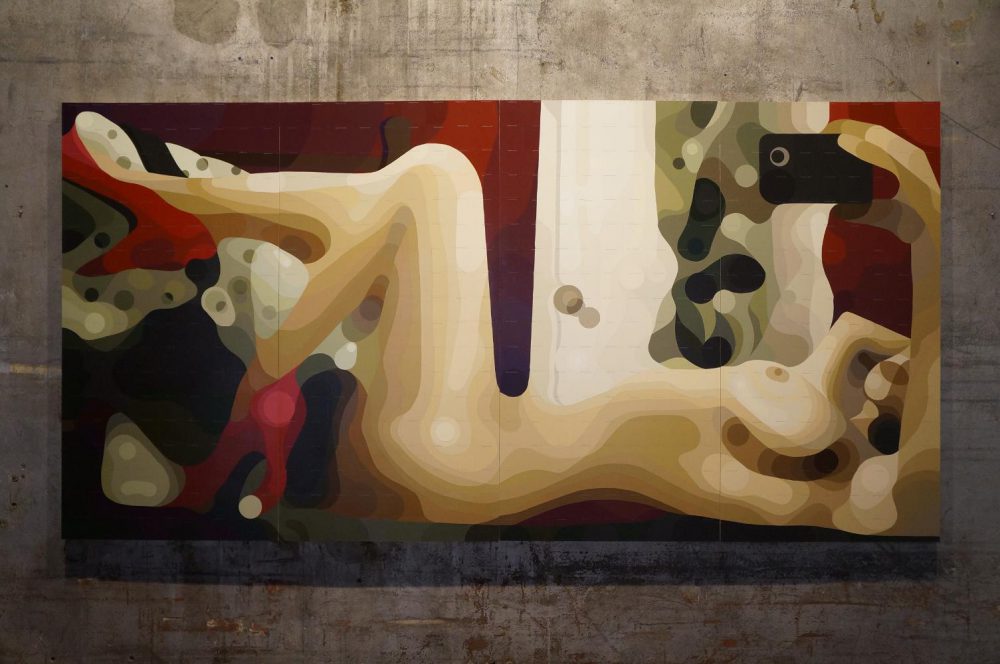Perverse Americana: Carlton Scott Sturgill at Engine Room Art + Projects
Lauren Scarpello looks at a recent exhibition by Carlton Scott Sturgill that attempted to unearth the sexual fantasies often hidden in daily life.

Carlton Scott Sturgill, Garden of Delights, 2016. Mixed-media installation. Courtesy the artist.
Highlighting the struggle between outward appearances and inward desires, Carlton Scott Sturgill uses sheared swaths of fabric from Ralph Lauren shirts to craft faux roses and Home Depot paint swatches to assemble mosaic collages in “Glass Houses,” his recent exhibition at Engine Room Art + Projects. These materials are stand-ins for keeping-up-with-the-Joneses Americana and its stresses. Specifically, Sturgill fixates on Craigslist Casual Encounters seekers, inventing a mythic backstory where members of this online subculture are balancing their inner urges with societal standards of perfection.
The roses creep up the anteroom wall of the exhibition and fill the interior of the centerpiece installation consisting of an adage-inspired glass house, Garden of Delights, 2016. Containing a bed with a classic wrought-iron frame, the house is like a cage for a menagerie overtaken with wild rose bushes. The flowers, held together with wire and green fabric tape, resemble craft-store silk flowers one might purchase to create your own wreath or floral wall spray.
At first glance, it’s possible to mistake the paint-chip mosaics on the gallery walls surrounding the glass house for traditional paintings. Sturgill uses the hardware-store sample paint chips in two disparate series of two-dimensional works: one of vertical-stripe patterns on panel reminiscent of designer bed linens or wallpaper and another of blown-up erotic images pulled directly from actual personal ads.
Anyone who has ever visited a paint section of a hardware store and taken home a fist full of paint-chip samples knows that they weren’t just taking home various hues of “yellow.” In a collection, one might find chips imprinted on the front with “marigold,” “buttercream,” or other campy titles. Sturgill uses the paint names to his advantage, piecing together the letters to spell out words and phrases like anonymous ransom notes. The results are vertical patterns of color, and, when approached up close, the viewer can see the actual verbiage from a Craigslist post spelled out in tiny, silver letters.
In Mid 30’s attractive couple looking for friends – mw4mw, 2010, Sturgill assembled letters from the paint chips to spell out the contents of the posting. The resulting pattern contains hues of blue, brown, and yellow. Since the colors of the pattern are determined by the names of the paint colors, the patterns have an element of synesthesia—words turning into visuals.

Carlton Scott Sturgill, Hot Couple Looking for Sexy Third - mw4w - 2429 (San Francisco), 2017. Paint-chip mosaic on panel. Courtesy the artist.
In the figurative works, the faces are almost always already cropped or obscured by the users and Sturgill adds in another layer of anonymity by staging them as oversize blurred-out photographs from afar. Up close the materials of choice, paint swatches, become obvious and the images morph into paint-by-number collages, giving them a Pop Art sensibility. For instance in Hot Couple Looking for Sexy Third – mw4w – 2429 (San Francisco), 2016, we can make out a reclining faceless nude female in red stilettos that calls to mind the erotic consumerism of Tom Wasserman’s Great American Nudes from the 1960s.
In both of the works that use paint chips there is an interplay between what one sees from afar and how things look up close. This could be a manifestation of how multiple narratives can be true at the same time, like leading a secret double life that polite company would reject.
The takeaway materials available at the gallery described the works on view as “grappl[ing] with voyeurism and exhibitionism…in a society obsessed with selfies.” I wasn’t entirely convinced that this was the message these works conveyed and I actually thought this description undercut the potential herein. Every corner of the Internet is full of double-lives—whether it’s sex seekers on Craigslist or political trolls on Reddit. The strengths of the work seem to lie more with the materials and methods in a broader sense, rather than this narrative of the pervasiveness of individuals with private lives upon which the public frowns.
I saw Sturgill’s choice of materials as a case of art history repeating itself. Just as television—or rather the disillusionment of television as a source of veracity—ushered in Pop Art and Poststructuralism, Sturgill’s Internet-inspired works respond to the “post-truth” era of fake news and “alternative facts” with direct nods to commodification and the absence of the artist’s hand.
Unfortunately, his critiques and the questions raised by his use of materials become lost to the inappropriateness of location choice. The work was thought-provoking, to be sure, but given the location, it ironically fell short. This was the inaugural exhibition in the newly renovated Engine Room Art + Projects space—located in a warehouse filled with artist studios on North Robinson Avenue that used to be home to May Gallery & Residency—in New Orleans, a city where do-it-yourself short-term-rental developers are encroaching even further into middle-class and low-income neighborhoods.
To wit, cultural authenticity is being perverted and replaced with tacky mass-produced condos and apartments for tourists. The concepts of voyeurism and identity were marketed as the theses of this exhibition, but Sturgill's view of Americana, which he critiques, is actually a part of the same culture of gentrification that's spreading through the Ninth Ward, where the gallery is located. As a result by the end, I was left wondering—who really cares about these existential crises of the privileged?
Editor's Note
Carlton Scott Sturgill’s “Glass Houses” was on view January 12 – February 11, 2017, at Engine Room Art + Projects (2839 N. Robertson Street) in New Orleans.



